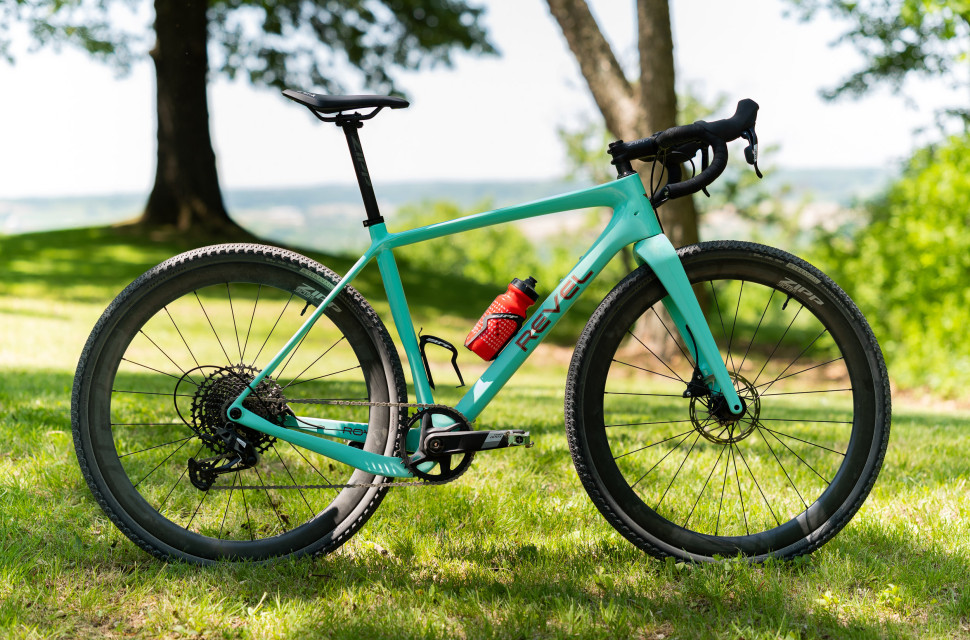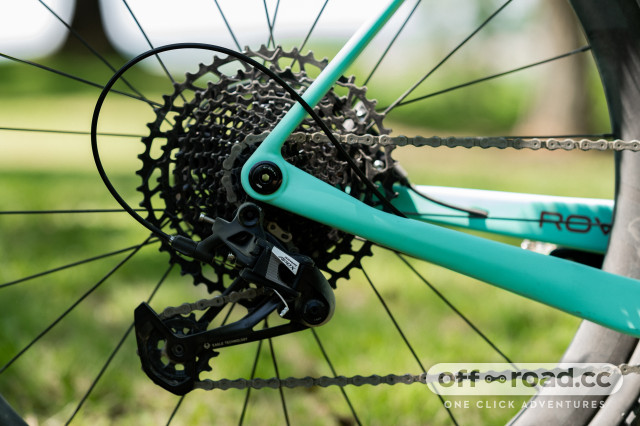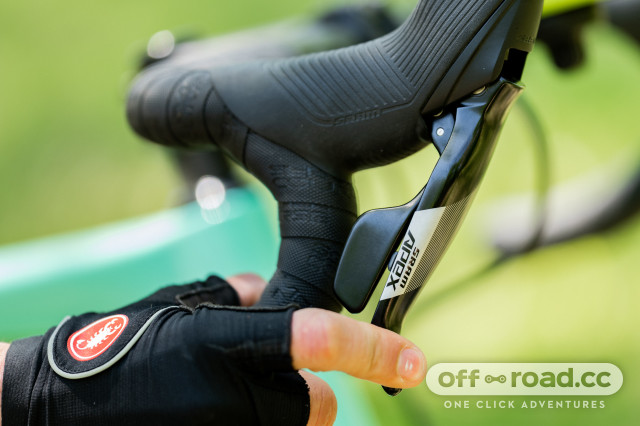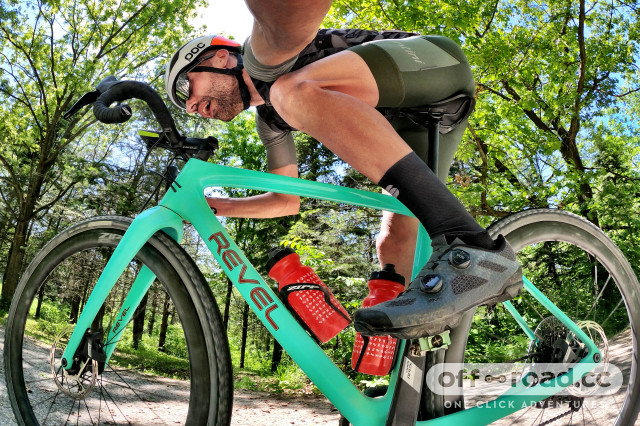SRAM Apex Eagle mechanical first ride review - "we’ve never given up on mechanical shifting"

Rim brakes might be dead but the purity afforded by mechanical shifting systems still makes a convincing case in terms of reliability and affordability, especially considering the financial challenges many of us are currently facing. Many riders still argue mechanical gearing has a place in contemporary cycling and SRAM seems committed to backing the analogue experience, too.
The company has remained committed to cable actuation with the launch of its all-new 12-speed Apex mechanical groupset, which was revealed to the cycling media alongside SRAM Apex AXS at the international product launch in Galena, Illinois. You can read the SRAM Apex XPLR AXS first ride review over on our sister site road.cc.
- Best gravel bikes under £1500 in 2023
- RockShox rear shocks 2023
- SRAM mountain bike brakes 2023 - Level, G2 and Code models
We got to sample the new groupset over a variety of terrain types and even sneaked in a cheeky extra session to ensure we got a proper feel for how it all works and what it means for you.
Here’s everything you need to know.
Same, same but slightly different
Visually, save for the cables, there’s nothing really separating SRAM Apex mechanical from the Apex AXS - and that’s a good thing based purely on how premium both groupsets look. Keeping the treatment uniform would have been a key focus in the planning phase and the Apex range utilises SRAM’s corporate ID quite effectively as a result.
Like Apex XPLR AXS and Eagle AXS, the mechanical versions share the same Apex 1 Wide crankset, control interface and brake calipers. It gets the same drop-bar layout complete with the new-look slim hood design and textured treatment which serves as both a visual and functional measure. That said, if it’s an MTB-style flat-bar brake lever arrangement you’re after, SRAM does offer S300 flat-bar brakes which can be paired with a trigger shift or Grip Shift actuation. The Apex 1 crankset is compatible with both flat-top and Eagle chains, rear mech dependent of course.
SRAM also takes rider feedback to heart and subsequently looked at the lever shape to avoid it making contact with the bar under certain braking situations. The levers now possess a slight outward flare to nullify this possibility - it's a small detail but I noticed it immediately and appreciate this kind of forward-thinking design.
OEM chainring options range from 38-42T, but a steel 40T unit is standard fare. Like AXS, there's also a 44T and 46T chainring available as an aftermarket upgrade. There are a few cassette arrangements available, too, depending on whether you go XPLR or Eagle. The spread is pretty much the same as AXS, the difference being XPLR which is compatible with 11-44T and 10-44T cassettes only in mechanical guise. Eagle customers can choose from the same 11-50T, 10-50T and 10-52T. Like AXS, the 11-44T XPLR and 11-50T Eagle cassette will fit a traditional 11-speed HG-style driver body for broader integration (it is not XDR compatible).
The weight weenies among us will be delighted to learn that Apex XPLR and Eagle mechanical groupsets weigh less than their AXS counterparts with Apex XPLR coming in at 2,882g (18g less than XPLR AXS) and Apex Eagle tipping the scales at 3,072g (119g less than Eagle AXS). The Quarq DUB-PWR spindle-based power meter is also an option - it costs £200 / $250 and adds roughly 40g to the build.
Riding impression - is digital killing off the analogue star?
While electronic groupsets have fast-tracked the extinction of many mechanical offerings, SRAM has categorically stated, "We’ve never given up on mechanical shifting". The American company has pioneered many firsts in the mechanical space including Grip Shift back in 1987, DoubleTap, the ESP rear derailleur which produced superlative shifting performance and cable management thanks to the 1:1 shift actuation ratio and the single chainring. These innovations are cornerstones of the SRAM philosophy and paved the way for its 1x12-speed XPLR and Eagle systems.
Like many diehards, I feel there’s still a place for mechanical shifting in today’s digital world - especially considering the simplicity and purity of how it operates. After all, the bulletproof nature of a mechanical system does provide a certain peace of mind that battery-operated systems lack. And then there’s the feedback from the mechanical system. The shift lever provides a tactile experience thanks to deliberate and audible clicks when swapping cogs. For the mechanical testing session, I was handed a Revel Rover outfitted in Apex Eagle and, while the route comprised open district gravel roads and no technical singletrack, the sharp and punchy topography provided a good testbed for the Eagle gearing and shifting.
Speaking of shifting, Apex mechanical is built around SRAM's DoubleTap shifting protocol. It's an intuitive approach to shifting that speeds up the entire experience - a single tap takes care of downshifts while the sweeping motion of the fingers ensures rapid response on the ups. During the test ride, adapting to mechanical was a breeze and it didn't feel any less precise than the AXS equivalent. The gear changes are fluid, crisp and sophisticated. It doesn't feel entry-level and does nothing to hinder performance on the bike.
Like AXS, the levers are reach adjustable to accommodate a wider range of hand and finger sizes. This can be carried out using a 2mm Allen key. As mentioned, the brake system is identical to that of Apex XPLR AXS and AXS Eagle, which means the same flat-mount Level caliper design. Stopping power allows you to confidently scrub off speed with precision and it's in these situations where the flared lever makes the world of difference when braking super-hard - no bar contact here.
In terms of gearing, my Revel Rover employed a 40T chainring paired with an 11-50T cassette - SRAM calls this a mullet configuration which makes total sense. This combination proved to adequately dismiss most of the day's challenges, including some high-speed stretches of rolling terrain. While speeds were south of 40km/h for the most part, the 11T sprocket did manage to see a bit of action and highlighted the logic behind the stock gearing set-up. I didn't need to use the 50T at any point during the ride but knowing it was there did provide some mental comfort towards the end of my 105km ride.
Early verdict, pricing and availability
While the industry has seen a significant move to electronic shifting in recent years, not to mention more accessible pricing across the board to sweeten the allure even further, there’s still an appetite for mechanical groupsets. SRAM’s Apex Eagle mechanical is a case in point - it’s superbly designed, looks the part and executes shifting and braking responsibilities to perfection. Of course, it doesn’t have the brand cache of AXS and lacks that minimalist electronic look but it does just as good a job - while weighing and costing less.
As a current user of mechanical shifting on my SRAM XX1 Eagle-equipped Trek Procaliber hardtail mountain bike, I like everything about the new 12-speed Apex mechanical and how it manages to bring the AXS gearing philosophy to analogue riders. While I’d be hard-pressed to choose between Apex AXS and Apex mechanical - yes, both groupsets are that good - there’s nothing watered down about either of them and sharing this fact is probably the most important message I can relay to you, dear reader.
At £1,015 / $947 / €1,126 (XPLR mechanical groupset) and £986 / $929 / €1,095 (Eagle mechanical groupset), SRAM has nailed the pricing and specification sheet. SRAM Apex mechanical will be available from September 2023.
Tech specs
SRAM Apex XPLR mechanical
Price: £1,015 / $947 / €1,126
Shifting: Mechanical
Braking: Hydraulic disc
Speeds: 1x12
Weight: 2,882g
Cranks: Aluminium, 160mm - 175mm
Chainrings 1x: 38T, 40T, 42T (44T,46T aftermarket)
Cassette: 11-44T, 10-44T
SRAM Apex Eagle mechanical
Price: £986 / $929 / €1,095
Shifting: Mechanical
Braking: Hydraulic disc
Speeds: 1x12
Weight: 3,072g
Cranks: Aluminium, 160mm - 175mm
Chainrings 1x: 38T, 40T, 42T (44T,46T aftermarket)
Cassette: 11- 50T, 10-50T, and 10-52T














